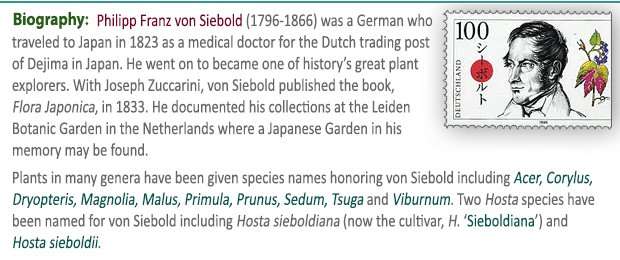|
 This sport of H. 'Tardiflora' is a non-registered cultivar from
Japan and
Dr.
Shuichi Hirao. It forms a small size plant about 7
inches high with a spread of 15 inches. The dark green leaves
have a lighter green medial (center) variegation. Pale purple
flowers bloom in September. This sport of H. 'Tardiflora' is a non-registered cultivar from
Japan and
Dr.
Shuichi Hirao. It forms a small size plant about 7
inches high with a spread of 15 inches. The dark green leaves
have a lighter green medial (center) variegation. Pale purple
flowers bloom in September.
The New Encyclopedia of Hostas by
Diana
Grenfell (2009) states in its Hosta Hybrids for Connoisseurs chapter: "Site
in light to moderate shade in a raised bed or a container so that the unusual
leaves can be enjoyed close up. Grown by serious hosta collectors rather than
general gardeners...The swollen areas which are a stable generic trait, are more
prominent in some leaves than others and give the leaf a somewhat contorted
effect (koryu means "swollen variegation")."
 "...the
"hosta with swollen variegation." The variegation is in relief and looks like
Ryu, "dragon on the leaves." Coveted in Japan for its peculiar look...sometimes
called H. 'Miyakodon'...In North America this cultivar name is also used
incorrectly for various H. sieboldii seedlings." "...the
"hosta with swollen variegation." The variegation is in relief and looks like
Ryu, "dragon on the leaves." Coveted in Japan for its peculiar look...sometimes
called H. 'Miyakodon'...In North America this cultivar name is also used
incorrectly for various H. sieboldii seedlings."
Mikiko Lockwood in an article on The Hosta Library titled,
A Little About Japanese Hosta Terms defines the term koryu or Kouryu as a raised ridge along the center
of a leaf.

 An article about H. 'Koryu' by Warren I. Pollock in
The
Hosta Journal (2001 Vol. 32 No. 2) states that, "Tony (Avent) goes on to explain: "This very distinctive collector's plant, a
H. longipes (selection or hybrid) which is highly coveted in Japan, was originally
discovered by Dr. Shuichi Hirao. This is the same plant the
Ralph "Herb"
Benedict named H. 'Fused Veins', after not being able to determine the true
identity." An article about H. 'Koryu' by Warren I. Pollock in
The
Hosta Journal (2001 Vol. 32 No. 2) states that, "Tony (Avent) goes on to explain: "This very distinctive collector's plant, a
H. longipes (selection or hybrid) which is highly coveted in Japan, was originally
discovered by Dr. Shuichi Hirao. This is the same plant the
Ralph "Herb"
Benedict named H. 'Fused Veins', after not being able to determine the true
identity."



 |



